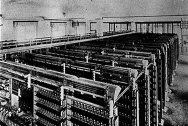
|
||

|
In March 1926 the Yokohama Central Telephone Office begins using automated exchange equipment, consisting of Siemens Hallske switchboards imported from Germany. These are also step-by-step switching devices, but the use of Strowger equipment in Tokyo and Siemens Hallske equipment in Yokohama is the result of accepting tenders from multiple overseas vendors in an attempt to obtain lower prices through international competitive bidding. The same Siemens Hallske type equipment will be imported for use in Osaka and Kobe, however by Showa 9 (1934) a Japanese-made exchange called the Type H exchange will be available. The obsolescence of manual exchanges combined with the conversion to automated exchanges after the Great Kanto Earthquake create an occasion for public information lectures that are held in department stores and schools. | |

|
||